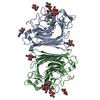+ データを開く
データを開く
- 基本情報
基本情報
| 登録情報 |  | |||||||||
|---|---|---|---|---|---|---|---|---|---|---|
| タイトル | Cryo-EM structure of Maackia amurensis seed Leukoagglutinin (lectin), MASL | |||||||||
 マップデータ マップデータ | ||||||||||
 試料 試料 |
| |||||||||
 キーワード キーワード | Seed Lectin / Maackia amurensis / N-linked glycosylation / Intersubunit Disulphide bridge / leukoagglutinin / SUGAR BINDING PROTEIN | |||||||||
| 機能・相同性 |  機能・相同性情報 機能・相同性情報 | |||||||||
| 生物種 |  Maackia amurensis (イヌエンジュ) Maackia amurensis (イヌエンジュ) | |||||||||
| 手法 | 単粒子再構成法 / クライオ電子顕微鏡法 / 解像度: 2.84 Å | |||||||||
 データ登録者 データ登録者 | Nayak AR / Goldberg GS / Temiakov D / Sedmen J / Zamudio-Ochoa A | |||||||||
| 資金援助 |  米国, 1件 米国, 1件
| |||||||||
 引用 引用 |  ジャーナル: J Biol Chem / 年: 2025 ジャーナル: J Biol Chem / 年: 2025タイトル: Maackia amurensis seed lectin structure and sequence comparison with other M. amurensis lectins. 著者: Ashok R Nayak / Cayla J Holdcraft / Ariel C Yin / Rachel E Nicoletto / Caifeng Zhao / Haiyan Zheng / Dmitry Temiakov / Gary S Goldberg /  要旨: Maackia amurensis lectins, including MASL, MAA, and MAL2, are widely utilized in biochemical and medicinal research. However, the structural and functional differences between these lectins have not ...Maackia amurensis lectins, including MASL, MAA, and MAL2, are widely utilized in biochemical and medicinal research. However, the structural and functional differences between these lectins have not been defined. Here, we present a high-resolution cryo-EM structure of MASL revealing that its tetrameric assembly is directed by two intersubunit disulfide bridges. These bridges, formed by C272 residues, are central to the dimer-of-dimers assembly of a MASL tetramer. This cryo-EM structure also identifies residues involved in stabilizing the dimer interface, multiple glycosylation sites, and calcium and manganese atoms in the sugar-binding pockets of MASL. Notably, our analysis reveals that Y250 in the carbohydrate-binding site of MASL adopts a flipped conformation, likely acting as a gatekeeper that obstructs access to noncognate substrates, a feature that may contribute to MASL's substrate specificity. Sequence analysis suggests that MAA is a truncated version of MASL, while MAL2 represents a homologous isoform. Unlike MASL, neither MAL2 nor MAA contains a cysteine residue required for disulfide bridge formation. Accordingly, analysis of these proteins using reducing and nonreducing SDS-PAGE confirms that the C272 residue in MASL drives intermolecular disulfide bridge formation. These findings provide critical insights into the unique structural features of MASL that distinguish it from other M. amurensis lectins, offering a foundation for further exploration of its biological and therapeutic potential. | |||||||||
| 履歴 |
|
- 構造の表示
構造の表示
| 添付画像 |
|---|
- ダウンロードとリンク
ダウンロードとリンク
-EMDBアーカイブ
| マップデータ |  emd_47565.map.gz emd_47565.map.gz | 19.1 MB |  EMDBマップデータ形式 EMDBマップデータ形式 | |
|---|---|---|---|---|
| ヘッダ (付随情報) |  emd-47565-v30.xml emd-47565-v30.xml emd-47565.xml emd-47565.xml | 23 KB 23 KB | 表示 表示 |  EMDBヘッダ EMDBヘッダ |
| FSC (解像度算出) |  emd_47565_fsc.xml emd_47565_fsc.xml | 7.1 KB | 表示 |  FSCデータファイル FSCデータファイル |
| 画像 |  emd_47565.png emd_47565.png | 82.1 KB | ||
| Filedesc metadata |  emd-47565.cif.gz emd-47565.cif.gz | 6.9 KB | ||
| その他 |  emd_47565_additional_1.map.gz emd_47565_additional_1.map.gz emd_47565_half_map_1.map.gz emd_47565_half_map_1.map.gz emd_47565_half_map_2.map.gz emd_47565_half_map_2.map.gz | 19.9 MB 35.6 MB 35.6 MB | ||
| アーカイブディレクトリ |  http://ftp.pdbj.org/pub/emdb/structures/EMD-47565 http://ftp.pdbj.org/pub/emdb/structures/EMD-47565 ftp://ftp.pdbj.org/pub/emdb/structures/EMD-47565 ftp://ftp.pdbj.org/pub/emdb/structures/EMD-47565 | HTTPS FTP |
-検証レポート
| 文書・要旨 |  emd_47565_validation.pdf.gz emd_47565_validation.pdf.gz | 703.8 KB | 表示 |  EMDB検証レポート EMDB検証レポート |
|---|---|---|---|---|
| 文書・詳細版 |  emd_47565_full_validation.pdf.gz emd_47565_full_validation.pdf.gz | 703.4 KB | 表示 | |
| XML形式データ |  emd_47565_validation.xml.gz emd_47565_validation.xml.gz | 14.6 KB | 表示 | |
| CIF形式データ |  emd_47565_validation.cif.gz emd_47565_validation.cif.gz | 18.6 KB | 表示 | |
| アーカイブディレクトリ |  https://ftp.pdbj.org/pub/emdb/validation_reports/EMD-47565 https://ftp.pdbj.org/pub/emdb/validation_reports/EMD-47565 ftp://ftp.pdbj.org/pub/emdb/validation_reports/EMD-47565 ftp://ftp.pdbj.org/pub/emdb/validation_reports/EMD-47565 | HTTPS FTP |
-関連構造データ
| 関連構造データ | 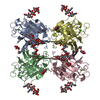 9e6hMC M: このマップから作成された原子モデル C: 同じ文献を引用 ( |
|---|---|
| 類似構造データ | 類似検索 - 機能・相同性  F&H 検索 F&H 検索 |
- リンク
リンク
| EMDBのページ |  EMDB (EBI/PDBe) / EMDB (EBI/PDBe) /  EMDataResource EMDataResource |
|---|---|
| 「今月の分子」の関連する項目 |
- マップ
マップ
| ファイル |  ダウンロード / ファイル: emd_47565.map.gz / 形式: CCP4 / 大きさ: 38.4 MB / タイプ: IMAGE STORED AS FLOATING POINT NUMBER (4 BYTES) ダウンロード / ファイル: emd_47565.map.gz / 形式: CCP4 / 大きさ: 38.4 MB / タイプ: IMAGE STORED AS FLOATING POINT NUMBER (4 BYTES) | ||||||||||||||||||||||||||||||||||||
|---|---|---|---|---|---|---|---|---|---|---|---|---|---|---|---|---|---|---|---|---|---|---|---|---|---|---|---|---|---|---|---|---|---|---|---|---|---|
| 投影像・断面図 | 画像のコントロール
画像は Spider により作成 | ||||||||||||||||||||||||||||||||||||
| ボクセルのサイズ | X=Y=Z: 0.93 Å | ||||||||||||||||||||||||||||||||||||
| 密度 |
| ||||||||||||||||||||||||||||||||||||
| 対称性 | 空間群: 1 | ||||||||||||||||||||||||||||||||||||
| 詳細 | EMDB XML:
|
-添付データ
-追加マップ: Sharpened map
| ファイル | emd_47565_additional_1.map | ||||||||||||
|---|---|---|---|---|---|---|---|---|---|---|---|---|---|
| 注釈 | Sharpened map | ||||||||||||
| 投影像・断面図 |
| ||||||||||||
| 密度ヒストグラム |
-ハーフマップ: #2
| ファイル | emd_47565_half_map_1.map | ||||||||||||
|---|---|---|---|---|---|---|---|---|---|---|---|---|---|
| 投影像・断面図 |
| ||||||||||||
| 密度ヒストグラム |
-ハーフマップ: #1
| ファイル | emd_47565_half_map_2.map | ||||||||||||
|---|---|---|---|---|---|---|---|---|---|---|---|---|---|
| 投影像・断面図 |
| ||||||||||||
| 密度ヒストグラム |
- 試料の構成要素
試料の構成要素
-全体 : Cryo-EM map of Maackia amurensis seed Leukoagglutinin (lectin), MASL
| 全体 | 名称: Cryo-EM map of Maackia amurensis seed Leukoagglutinin (lectin), MASL |
|---|---|
| 要素 |
|
-超分子 #1: Cryo-EM map of Maackia amurensis seed Leukoagglutinin (lectin), MASL
| 超分子 | 名称: Cryo-EM map of Maackia amurensis seed Leukoagglutinin (lectin), MASL タイプ: complex / ID: 1 / 親要素: 0 / 含まれる分子: #1 |
|---|---|
| 由来(天然) | 生物種:  Maackia amurensis (イヌエンジュ) Maackia amurensis (イヌエンジュ) |
| 分子量 | 理論値: 125 KDa |
-分子 #1: Seed leukoagglutinin
| 分子 | 名称: Seed leukoagglutinin / タイプ: protein_or_peptide / ID: 1 / コピー数: 4 / 光学異性体: LEVO |
|---|---|
| 由来(天然) | 生物種:  Maackia amurensis (イヌエンジュ) Maackia amurensis (イヌエンジュ) |
| 分子量 | 理論値: 31.32148 KDa |
| 配列 | 文字列: MATSNSKPTQ VLLATFLTFF FLLLNNVNSS DELSFTINNF VPNEADLLFQ GEASVSSTGV LQLTRVENGQ PQQYSVGRAL YAAPVRIWD NTTGSVASFS TSFTFVVKAP NPDITSDGLA FYLAPPDSQI PSGSVSKYLG LFNNSNSDSS NQIVAVEFDT Y FGHSYDPW ...文字列: MATSNSKPTQ VLLATFLTFF FLLLNNVNSS DELSFTINNF VPNEADLLFQ GEASVSSTGV LQLTRVENGQ PQQYSVGRAL YAAPVRIWD NTTGSVASFS TSFTFVVKAP NPDITSDGLA FYLAPPDSQI PSGSVSKYLG LFNNSNSDSS NQIVAVEFDT Y FGHSYDPW DPNYRHIGID VNGIESIKTV QWDWINGGVA FATITYLAPN KTLIASLVYP SNQTTFSVAA SVDLKEILPE WV RVGFSAA TGYPTEVETH DVLSWSFTST LEANCDAATE NNVHIARYTA UniProtKB: Seed leukoagglutinin |
-分子 #4: 2-acetamido-2-deoxy-beta-D-glucopyranose
| 分子 | 名称: 2-acetamido-2-deoxy-beta-D-glucopyranose / タイプ: ligand / ID: 4 / コピー数: 8 / 式: NAG |
|---|---|
| 分子量 | 理論値: 221.208 Da |
| Chemical component information | 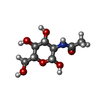 ChemComp-NAG: |
-分子 #5: CALCIUM ION
| 分子 | 名称: CALCIUM ION / タイプ: ligand / ID: 5 / コピー数: 4 / 式: CA |
|---|---|
| 分子量 | 理論値: 40.078 Da |
-分子 #6: MANGANESE (II) ION
| 分子 | 名称: MANGANESE (II) ION / タイプ: ligand / ID: 6 / コピー数: 4 / 式: MN |
|---|---|
| 分子量 | 理論値: 54.938 Da |
-実験情報
-構造解析
| 手法 | クライオ電子顕微鏡法 |
|---|---|
 解析 解析 | 単粒子再構成法 |
| 試料の集合状態 | particle |
- 試料調製
試料調製
| 濃度 | 0.4 mg/mL |
|---|---|
| 緩衝液 | pH: 7.9 詳細: 20 mM Tris-HCL (pH=7.9), 100 mM NaCL, 0.1 mM CaCl2, 0.1 mM MnCl2 |
| グリッド | モデル: UltrAuFoil R1.2/1.3 / 材質: GOLD / 支持フィルム - 材質: GOLD / 支持フィルム - トポロジー: HOLEY / 前処理 - タイプ: GLOW DISCHARGE |
| 凍結 | 凍結剤: ETHANE / チャンバー内湿度: 95 % / チャンバー内温度: 277 K / 装置: FEI VITROBOT MARK IV |
| 詳細 | 3 uM MASL monodisperse solution |
- 電子顕微鏡法
電子顕微鏡法
| 顕微鏡 | TFS GLACIOS |
|---|---|
| 特殊光学系 | 詳細: No Energy filter was used |
| ソフトウェア | 名称: EPU (ver. 3.6) |
| 詳細 | Calibrated pixel size -0.93 |
| 撮影 | フィルム・検出器のモデル: FEI FALCON IV (4k x 4k) 撮影したグリッド数: 1 / 実像数: 8543 / 平均電子線量: 60.0 e/Å2 詳細: Total number of frames - 40, Defocus range - -0.3 to -1.2 um in 0.1 increments, Output mode - TIFF, Autofocus recurrence - after centering, Drift measurement - once per grid square (Threshold - 0.4 nm/sec) |
| 電子線 | 加速電圧: 200 kV / 電子線源:  FIELD EMISSION GUN FIELD EMISSION GUN |
| 電子光学系 | C2レンズ絞り径: 50.0 µm / 照射モード: FLOOD BEAM / 撮影モード: BRIGHT FIELD / Cs: 2.7 mm / 最大 デフォーカス(公称値): 1.2 µm / 最小 デフォーカス(公称値): 0.3 µm / 倍率(公称値): 150000 |
| 試料ステージ | 試料ホルダーモデル: FEI TITAN KRIOS AUTOGRID HOLDER ホルダー冷却材: NITROGEN |
 ムービー
ムービー コントローラー
コントローラー




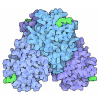
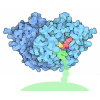
 Z (Sec.)
Z (Sec.) Y (Row.)
Y (Row.) X (Col.)
X (Col.)













































